It is an hour to sunset when I arrive at Devi Kund Sagar in Bikaner that February evening. I have just arrived from Mumbai earlier that day and this is one of the first sites I am visiting in Bikaner. Never having seen cenotaphs for Hindus before, I am very curious and intrigued about this visit and am not sure what to expect when I walk into the complex. (I didn’t know then that Devi Kund Sagar is only the first of the many Hindu cenotaphs I will be seeing during the course of my Rajasthan trip).
Located about 8 km from Bikaner, Devi Kund Sagar has been the cremation ground for the royal family of Bikaner and generations of kings, queens, princes and princesses of Bikaner have a memorial to their names here. According to the information board at the entrance to the complex, the oldest cenotaph at the Devi Kund Sagar is that of Rao Kalyanmal Ji (1539-1571 AD).
Rows upon rows of pillared and open-sided domed cenotaphs are spread out before me when I enter the L-shaped enclosure after removing my footwear. The place is empty, save for the caretaker and a couple of children playing hide and seek between the various structures. The base of each of these domed and pillared structure is mostly square, and sometimes hexagonal or rectangular. Locally, the cenotaphs are called chhatris due to the domes, which look like umbrellas (chhatris).

While most of the cenotaphs are made of marble, some are built from red Bikaneri sandstone and topped with a marble chhatri. An exploration of the various cenotaphs reveal the differences in the representation of cenotaphs for men, women and children. While the cenotaph of a male has a vertical memorial slab, that of a female has feet engraved on a stone slab. A memorial for a minor is a simple structure called nada and does not have a chhatri covering it.
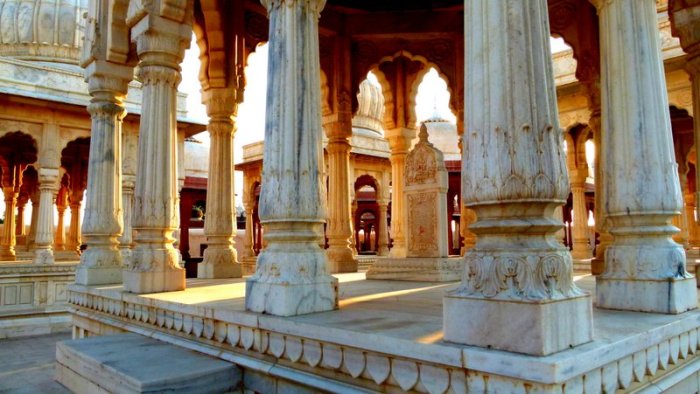
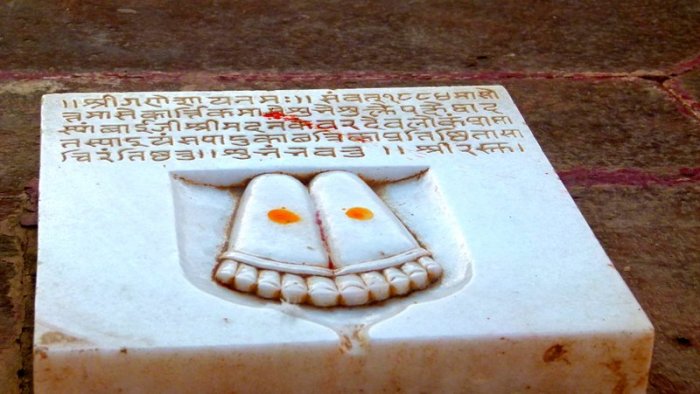

The chhatris appear plain and unadorned until you look up and see the fabulous artwork inside the domes. Some have been painted with gold, while others are frescoes using vegetable dyes. Sadly, most of them are in a bad condition.

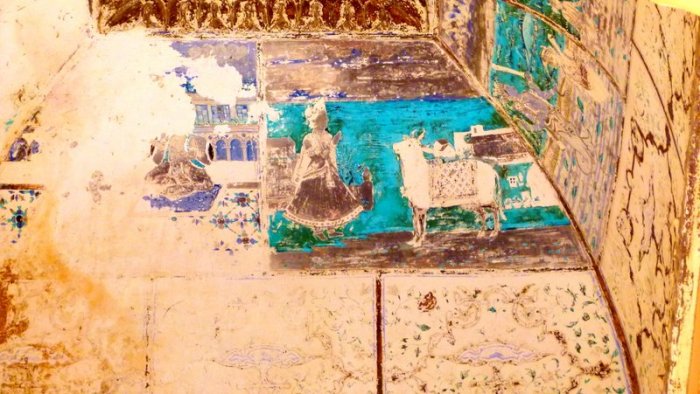
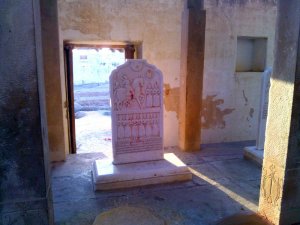
None of the cenotaphs carry any information as to whose it is in English and after a while, it does get a little frustrating and tedious to read the information in Hindi. The oldest cenotaphs are deep inside the enclosure and some of the memorials there are grouped under one chhatri. The memorial slabs here are also different — they depict a man on a horse along with women standing with folded hands.
I don’t know why, but these memorial slabs make me very uneasy and a Sati Mata Temple right next to these cenotaphs only add to the unease.
My unease is explained when I visit Bada Bagh, the site of the cenotaphs of the rulers of Jaisalmer, 3 days later. Bada Bagh is about 6 km from Jaisalmer and here too, I arrive an hour or so before sunset. The setting of Bada Bagh is dramatically stunning. The chhatris appear to sprout from the very rocks they are built on and since they are the same colour as the landscape around them, also appear like a mirage. The towering windmills in the distance only add to the fantastic photo-ops the area has to offer and I find it rather tough to put my camera away.


Like the chhatris at Devi Kund Sagar, the base of the chhatris at Bada Bagh are mostly square or hexagonal. The domes, however, are in a variety of shapes, ranging from the simple circular, to squarish to pyramidal and are also free from any kind of artwork. Most of the individual cenotaphs have boards giving the name and reign of the Jaisalmeri ruler in question. As I climb to the highest point in Bada Bagh and look around me, the cenotaphs glow golden in the light of the setting sun and throw into relief the general state of disrepair and decay they are in.


 Since the chhatris at Bada Bagh are only for the various male rulers of Jaisalmer, the memorial slabs are all placed vertically. All of them depict a man on a horse and most of these slabs also have women with folded hands sculpted on them. The number of these figures vary from slab to slab—from 1 to 16.
Since the chhatris at Bada Bagh are only for the various male rulers of Jaisalmer, the memorial slabs are all placed vertically. All of them depict a man on a horse and most of these slabs also have women with folded hands sculpted on them. The number of these figures vary from slab to slab—from 1 to 16.
My unease returns and as I ponder over the significance of these women on the memorial slab once again, a tourist group and their guide walk up to the cenotaph I am at. As I listen to the guide talk about the chhatris and the memorial slabs, I finally understand what the carvings on the slab represent — the man on the horse represents the Jailsalmeri ruler who died in battle or was murdered or of natural causes and the women on the slab represent the number of wives he had and who committed sati on his funeral pyre.
I leave Bada Bagh feeling shaken and vowing never to step into another chhatri or cenotaph complex if I could help it. But 2 days later, I am at the gates of the Jaswant Thada near Mehrangarh Fort in Jodhpur.
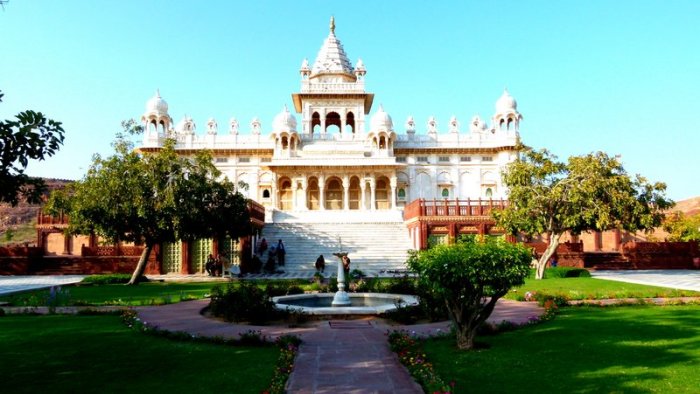
The Jaswant Thada is a marble memorial built by Maharaja Sardar Singh in memory of his father, Maharaja Jaswant Singh II, the 33rd Rathore ruler of Jodhpur. Built in 1889, the cenotaph looks like a cross between a Birla temple and a palace. The intricately carved marble exterior is made from thin sheets of marble with the result that the memorial appears to emit light from within. The large hall inside the Jaswant Thada displays portraits of the rulers of Jodhpur on its walls and from its windows, one can see some stunning views of Jodhpur. The Jaswant Thada Complex also houses the royal crematorium, some smaller cenotaphs and memorials that I do not bother to explore.

I must admit that part of the reason is because I want to avoid seeing more evidence of sati and partly because I am tired of seeing cenotaphs. Apart from the architectural curiosity and interest the cenotaphs arouse in me, I find them to be frankly quite creepy, particularly the memorial slabs of men on horses and women with folded hands. So when I am in Udaipur, I decide to give the Ahar Cenotaphs, the site for Maharajas of Mewar, a miss.
But my cenotaph story doesn’t end here; I have one more story to share and for that we have to go back to Jaisalmer.
I am quite upset after my visit to Bada Bagh and, Sushil, my driver notices it. He suggests that I visit Vyas Chhatri, the place where the celebrated sage Veda Vyasa has a cenotaph. When I tell Sushil that I am not interested in seeing any more cenotaphs, he tells me that Vyas Chhatri is also known as Jaisalmer’s sunset point and I could get some great photographs of Jaisalmer Fort from there. I reluctantly agree and that is how I arrive there at sunset.
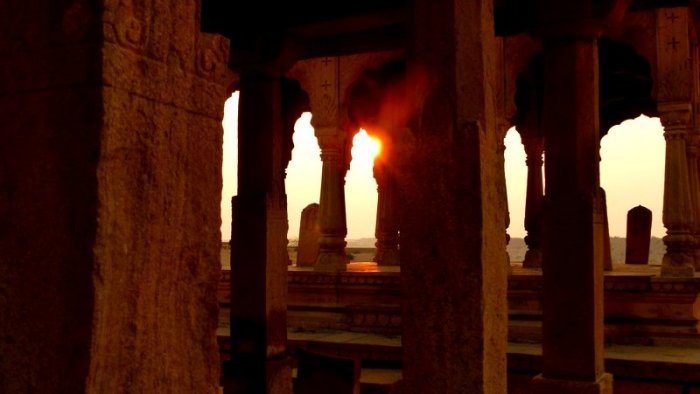

The cenotaphs at Vyas Chhatri are quite similar in structure to those at Bada Bagh, but are better maintained and fewer in number. The memorial slabs are also different and I cannot believe my eyes at what I see on them:

I am quite taken aback with this depiction of winged angels on the memorial slab as I have never come a depiction of an angel in Hinduism before. Making a mental note to read up on this, I cross the last of the cenotaphs and come up short when I see this:

I am quite horrified to see ashes smouldering away at a funeral pyre. While I am many kinds of tourists, gawking at a funeral pyre type of tourist, I am not. I leave immediately and when I get into the car, I ask Sushil as to why he didn’t tell me that the place was still used for cremation. He just shrugs and says, well there are not that many Brahmins dying everyday.
To which I ask if there are caste-based crematoria in Jaisalmer. And he nods proudly and says that the caste-based Hindu crematoria are located in different corners of Jaisalmer and that is how they have been for centuries and that is how they will be for centuries to come.
I open my mouth to argue and then shut it for I know that nothing that I say is going to make a difference. I am an outsider after all. I may be given a hearing, people may nod their heads, and then go and do what they have been doing all these years. Be it their loving reverence towards sati or their belief in a caste-based system, nothing is going to change.
And I can’t tell you how depressed this thought that made me that day and still continues to do so. 😦

Hey I understand your feeling of being angry and decrying some stuffs practiced out there. But, the photos are brilliant and the travel post nicely told:)
LikeLike
Thank you, Vishal. But it must not be forgotten what lies within all the beauty and behind the brilliance of the photos and setting. 😦
LikeLike
among all these, the only one I visited was Jaswant Thada, and even then just saw the main chhatri and gave the rest a miss. i didnt see any of these sati memorials either…. now i can understand why you mentioned that these were creepy, any mention or reminder of sati is sad…. as to the separate crematoriums, well, thats a reality in most places…..another sad fact of indian life… and as you say, there is really no point discussing it… they will just nod their heads and think we are nuts for thinking differently…. it also reminds me of a discussion i had with my guide in wayanad on this trip… about the concept of restricting entry to temples based on caste/ reliigion / sex…. they are so used and comfortable with the concept, they really cant see whats wrong with it…. anyway, thats a story for another time 😀
LikeLike
The Jaswant Thada does not even look like a cenotaph. The exterior looks like a palatial temple and the interiors are like a temple. And with the gardens and a small lake playing host to many migratory birds, the setting is idyllic and one can be forgiven for thinking that it is a picnic spot.
I am well aware of caste-based crematoriums, Anu, and know that they exist even in a city like Mumbai. It’s is just that every reiteration, every justification, further shakes me up. I know it shouldn’t, but it still does particularly when it is done with such pride and as a matter of honour.
LikeLike
and i just realised that you have posted after such a long time….. i was thinking of having a good time reading all your posts that i had missed, and there was just this one! so busy?
LikeLike
No, I hadn’t posted after May 2nd. It is combination of being busy and writer’s block. 😦
LikeLike
Wowww.. They look so beautiful. You have captured and described them wonderfully.
http://rajniranjandas.blogspot.in/2013/05/nagaon-beach-mini-goa.html
LikeLike
Thank you, Niranjan.
LikeLike
You are so right, the cenotaphs are a window to a rich historical past and yet they are marred with the glorification of sati. I was a kid when the Roop Kanwar episode had occured and it still gives me shivers.
LikeLike
I was a teenager when the Roop Kanwar incident happened in 1987. I was shocked, but the true impact and meaning was felt and understood only when I visited Rajasthan.
LikeLike
Beautiful and disturbing.. even more disturbing are the people who seem to accept the sati practise. Or even the caste practise but I have seen that too many times to be surprised about it. Sad. Beautiful pictures though.
LikeLike
Welcome here, Carvaka, and thank you so much for stopping by and commenting.
History is not always palatable, so I can understand when certain parts are hidden or deliberately ignored. But to glorify a heinous act is something that I find it difficult to accept.
LikeLike
Great post indeed. Bada bagh seems to be nice location for portfolio photography. I think it is filmed in many Hindi movies. am I right?
LikeLike
Welcome here, Paresh, and thank you so much for your comments. The Bada Bagh is a picturesque location, so I guess it must have come up somewhere in films. But honestly speaking, I can’t recollect any.
LikeLike
Picture perfect.
LikeLike
Thanks, aamjunta. I hope that you didn’t just see the pictures and not read the post.
LikeLike
No, read the entire post also… you write very well…
LikeLike
Loved your pictures and descriptions. It is certainly barbaric to us now to read about sati but I guess it was something that people really did not think through in those days, much like a lot of us don’t think logically through how outdated and illogical the caste system is now. That we still think of a group of people as somehow sub human because their ancestors did something we consider inferior for a living boggles the mind, or rather it should!
Interstingly, today is the birthday of Vinayak D. Savarkar, or Veer Savarkar, one of my heroes. He not only fearlessly took on the British, but also the entrenched caste system and in fact, wrote that Indian society and Hinduism would flourish only if this was abolished, much like Dr. Ambedkar argued. This from a ‘Brahmin’! My own view is that what a person’s ancestors did for a living is irrelevant, and to classify people in castes on that basis is not only unfair and illogical, but unscientific as it has no basis in genetics, and does not impact one’s intelligence or abilities. And, as we are all descended from hunter-gatherers who evolved in Africa, we are truly one ‘caste’ if we go back far enough!
Sorry for the long rant, but hearing about discrimination against women and groups based on such fallacies makes me upset.
I wish such things did not occur, but sadly I think India lacks the maturity at this point to do the right thing. I hope things change though.
Back to your travel stories – I hope you travel more and write about all your trips!
LikeLike
Thank you for your comment, Nima, and for the relevant points raised. I agree with you when you say that you think that “ndia lacks the maturity at this point to do the right thing.”. I would like to take this further and say if India even wants to take it further, as we are so fixated on our “glorious past”!
LikeLike
Beautifully narrated tales, Sudha, as always. Good to see a post from you after so long! 🙂
Bada Bagh is beautiful. Stunning, in fact.
I can understand your depression on seeing these structures. Had I been in your shoes, I would have been depressed, too. 😦
Cenotaphs (or tombs) can be quite creepy. I remember visiting the building housing
Humayun’s tomb alone (the OH was on work) in Delhi. I was quite creeped out, seeing tomb after tomb after tomb. It was an interesting place to visit, but I couldn’t get out of it soon enough.
LikeLike
Ah ! I remember Humayun’s tomb. Those crypts at the base of the tombs kinda freaked me out as well, though not as much as the ones at Jaisalmer 😦
LikeLike
You’re right. That is creepy. What Rajasthan needs is some actual big cities. It’s harder (but not impossible) to be so caste-ist and anti-woman in big cities, although it brings in a whole new set of problems. Still, what could be worse than this?
LikeLike
Big cities only hide casteist tendencies, so I don’t think that is the answer. Call me a pessimist, but I don’t think casteism will ever go away in India, at least not in my lifetime.
LikeLike
I concur. Such a change will require a huge shift in thought and attitude, and this is nearly impossible with our varied communities, many of them have vested interests in maintaining the status quo, and are even proud of it!
LikeLike
Beautiful. Thanks for reminding me of my trip.
LikeLike
You’re welcome, Rajesh.
LikeLike
Rajasthan is one of the best places in India for travel….. Lovely photos with crisp description made this a wonderful post…. The cast system is a curse of India and still haunting us… Really a sad part of our culture……
LikeLike
My Rajasthan trip was full of incredible highs and lows, something that I have never experienced in any other place. In a way it has been my best trip and worst trip ever and also taught me that travel is not just about seeing things and enjoying. It is also about looking at a world that is familiar and alien at the same time and one that tested my patience and (non) judgemental attitude.
LikeLike
Hmm! Disquieting post. How true that large pockets of our country still cling to all that is negative in Hinduism when all the positives are being progressively jettisoned by all of us.
LikeLike
The thing is they don’t see it as negative, they only see it as tradition 😦
LikeLike
I came back to this creepy post today and it still feels creepy and uneasy… but yes, I cant help wanting to see the photos again–they haunt beautifully.
LikeLike
I like to call the cenotaphs creepily beautiful, so yes I know what you mean.
LikeLike
hi
that,s really seem awsome & photography angle is also very good. beautiful photos. 🙂
thanks,
ganesh photo
LikeLike
Thanks for the appreciation, Sandeep 🙂
LikeLike
It’s good to see the writer’s block is no more. Every culture carries in it elements that will cause future generations to hang their heads in shame. What is important is to learn from these mistakes. I am sure, even in Rajasthan the winds of change are blowing, so slowly that we can’t see it. But they’re blowing for sure. Take heart, Sudha!!
LikeLike
I hope so, Meera. I really hope that what you say is happening 🙂
LikeLike
This was awesom, Probably a live tour of Rajasthan..
Very Beautifully written with awesom pictures….. Thanks for sharing
LikeLike
Welcome to “My Favourite Things”, Manish and thank you so much for stopping by and commenting. Very happy that you liked the post and the pictures. 🙂
LikeLike
I have stumbled across your very interesting and educating blog via Google while researching for my trip to India and I feel soo lucky. Your posts are really beautifully written and I love those stunning pictures and even more so with intriguing tales (heartbreaking, sometimes, like this one) and insights. I’m going to have to spend my time catching up with all your posts. 😀
When you started mentioning those women sculptures and then sati, I’ve got goosebumps as, although, I am actually from Thailand, I have heard a lot about the ritual and it is really sad. I am not so sure if I want to include those places on my Rajasthan trip, now that I know the story behind it.
By the way, have you had more information on the angle memorial slab? I am very curious about it, too!
LikeLike